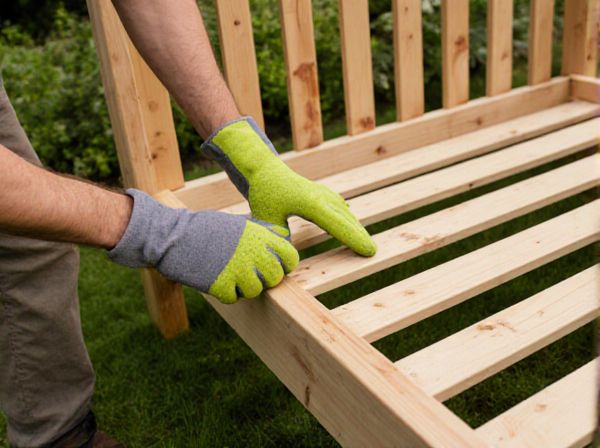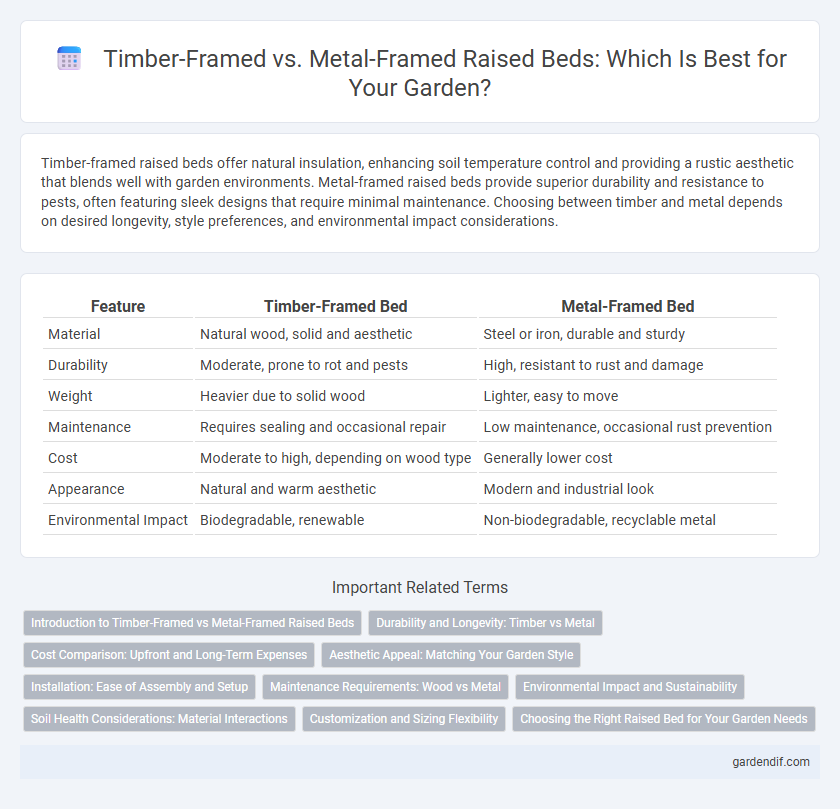
Timber-framed bed vs Metal-framed bed Illustration
Timber-framed raised beds offer natural insulation, enhancing soil temperature control and providing a rustic aesthetic that blends well with garden environments. Metal-framed raised beds provide superior durability and resistance to pests, often featuring sleek designs that require minimal maintenance. Choosing between timber and metal depends on desired longevity, style preferences, and environmental impact considerations.
Table of Comparison
| Feature | Timber-Framed Bed | Metal-Framed Bed |
|---|---|---|
| Material | Natural wood, solid and aesthetic | Steel or iron, durable and sturdy |
| Durability | Moderate, prone to rot and pests | High, resistant to rust and damage |
| Weight | Heavier due to solid wood | Lighter, easy to move |
| Maintenance | Requires sealing and occasional repair | Low maintenance, occasional rust prevention |
| Cost | Moderate to high, depending on wood type | Generally lower cost |
| Appearance | Natural and warm aesthetic | Modern and industrial look |
| Environmental Impact | Biodegradable, renewable | Non-biodegradable, recyclable metal |
Introduction to Timber-Framed vs Metal-Framed Raised Beds
Timber-framed raised beds offer natural insulation and a classic aesthetic that blends seamlessly with garden landscapes, often using rot-resistant woods like cedar for enhanced durability. Metal-framed raised beds provide superior structural strength and longevity, typically crafted from galvanized steel or aluminum to resist rust and weather damage. Choosing between them depends on factors such as budget, desired visual appeal, and maintenance preferences, with timber emphasizing organic charm and metal focusing on resilience and modernity.
Durability and Longevity: Timber vs Metal
Timber-framed beds offer natural durability with resistance to wear and potential for refinishing, enhancing longevity, especially when made from hardwoods like oak or maple. Metal-framed beds excel in strength and corrosion resistance, benefiting from powder-coated finishes that prevent rust and extend lifespan. While timber ages gracefully and can be repaired, metal frames generally provide superior longevity in humid environments and withstand heavy use without warping.
Cost Comparison: Upfront and Long-Term Expenses
Timber-framed beds typically have higher upfront costs due to the price of quality wood and craftsmanship but offer long-term durability and potential for refinishing, which can reduce replacement expenses. Metal-framed beds often come with lower initial prices and easier assembly, but may incur higher maintenance costs over time due to rust, bending, or the need for more frequent replacement. Evaluating total lifetime cost involves considering material longevity, maintenance frequency, and repair or replacement needs of each frame type.
Aesthetic Appeal: Matching Your Garden Style
Timber-framed raised beds offer a natural, rustic aesthetic that complements traditional and cottage garden styles, enhancing the organic feel with warm wood textures. Metal-framed raised beds provide a sleek, modern look ideal for contemporary or industrial garden designs, featuring clean lines and a durable finish that ages gracefully. Choosing between the two depends on your garden's overall theme and the visual harmony you want to create.
Installation: Ease of Assembly and Setup
Timber-framed beds typically offer straightforward assembly with pre-drilled holes and clear instructions, making setup manageable even for beginners. Metal-framed beds often feature lightweight, modular components with snap-together or bolt systems, enabling quick installation without extensive tools. Both options provide efficient setup, but timber frames may require more alignment effort, whereas metal frames prioritize speed and simplicity.
Maintenance Requirements: Wood vs Metal
Timber-framed beds require regular maintenance such as polishing, treating for pests, and avoiding excessive moisture to prevent warping and decay. Metal-framed beds demand less upkeep but need protection from rust through occasional painting or anti-corrosion treatments, especially in humid environments. Choosing between wood and metal frames depends on balancing the hands-on care of timber with the rust prevention measures for metal.
Environmental Impact and Sustainability
Timber-framed beds often have a lower environmental impact due to the renewable nature of wood and its ability to sequester carbon, especially when sourced from sustainably managed forests. Metal-framed beds usually involve higher energy consumption and greenhouse gas emissions during extraction and manufacturing but are highly durable and recyclable, potentially reducing waste over time. Choosing certified sustainable timber or recycled metal frames enhances eco-friendliness by supporting resource conservation and minimizing landfill contributions.
Soil Health Considerations: Material Interactions
Timber-framed raised beds naturally enhance soil health through organic material interaction, promoting microbial activity and nutrient cycling, while untreated wood can gradually decompose and enrich the soil. Metal-framed beds resist decay and pests but may alter soil pH due to potential rusting and metal ion leaching, which can affect plant growth. Choosing untreated or naturally rot-resistant timber minimizes chemical leaching, whereas galvanized or powder-coated metals help mitigate adverse soil interactions.
Customization and Sizing Flexibility
Timber-framed beds offer extensive customization options due to the ease of cutting, shaping, and finishing wood, allowing for unique designs and adjustable sizing to fit non-standard mattress dimensions. Metal-framed beds provide strength and durability but often come with preset dimensions and limited customization, as metal fabrication requires specialized tools and processes. For users prioritizing personalized design and flexible sizing, timber frames deliver greater adaptability compared to the more rigid configurations typical of metal frames.
Choosing the Right Raised Bed for Your Garden Needs
Timber-framed raised beds provide natural insulation and a classic aesthetic, ideal for maintaining soil warmth and blending with garden surroundings. Metal-framed raised beds offer superior durability and resistance to pests, making them a low-maintenance choice for long-term use. Selecting the right raised bed depends on factors such as climate, garden style, and longevity requirements, ensuring optimal plant growth and garden productivity.
Timber-framed bed vs Metal-framed bed Infographic

 gardendif.com
gardendif.com